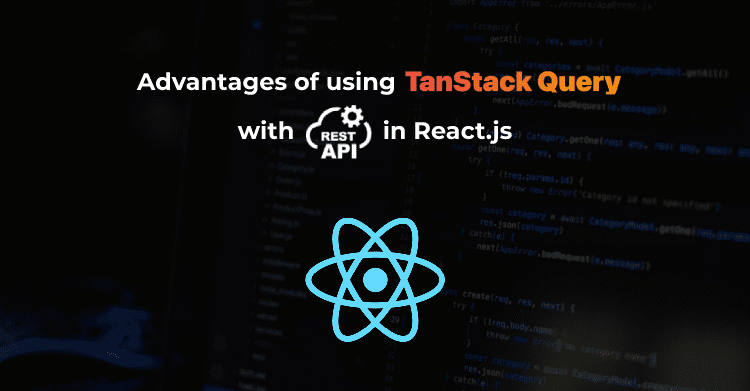
Blog
Advantages of using TanStack Query with REST API in React.jsPosted by
Elavarasu S on 21 Mar 2024
React.js has become one of the most popular JavaScript libraries for building user interfaces. Its flexibility and scalability have made it a go-to choice for many developers.
While REST APIs are widely used and have many benefits, there are some disadvantages, such as overfetching or underfetching, lack of real-time updates, complex state management, and overhead of multiple network requests, which affect user experiences when used with React.js.
When working with REST APIs, React developers are often challenged with managing data fetching, caching, and state management. Such problems can now be solved effectively with the help of TanStack Query (FKA React Query), a popular and powerful data fetching and state management library specifically designed for TS/JS, React, Solid, Vue, and Svelte applications. It simplifies the process of fetching, caching, updating, and synchronizing remote data.
Key features of TanStack Query
Before discussing how TanStack Query works with the REST API in React, let’s touch upon some of its key features.
Declarative API: TanStack Query provides a declarative API that allows developers to define data fetching and mutation operations using hooks and query keys, which makes it easy to fetch data and manage the state concisely and intuitively.
Background Data Refetching: TanStack Query supports background data refetching, ensuring that stale data is automatically updated in the background while still displaying the existing data. It provides a smooth user experience and keeps the application data up-to-date.
Query Invalidation and Refetching: TanStack Query allows developers to invalidate easily and refetch data based on events or triggers. For example, you can invalidate and refetch a query when a user submits a form or a specific event occurs, ensuring the data is always fresh and accurate.
Dev Tools and Debugging: TanStack Query offers a set of developer tools and debugging capabilities, providing insights into queries, caching, and network requests. These tools help identify performance bottlenecks and debug data-related issues.
Benefits of TanStack Query with REST API
We will explore the advantages of using TanStack Query with REST API in React.js and how it can streamline your development process.
Simplified Data Fetching
Fetching data from a REST API can involve handling complex scenarios such as pagination, filtering, sorting, and caching. TanStack Query simplifies this process by providing a declarative API that allows you to define your data-fetching logic using hooks. With TanStack Query, you can easily fetch, cache, and update data without dealing with the complexities of managing requests and responses manually. The following code fetches data using React-query:
// Data fetching using React-query
import { useQuery } from 'react-query';
const UsersList = () =>
// Fetch user data using useQuery hook from React Query
const { data, isLoading, error } = useQuery('users', () =>
fetch('https://api.example.com/users').then((res) => res.json())
);
// Display a loading message while data is being fetched
if (isLoading) {
return <div>Loading...</div>;
}
// Display an error message if there is an error during data fetching
if (error) {
return <div>Error: {error.message}</div>;
}
// Display the Users List once data has been successfully fetched
return (
<div>
<h1>User List</h1>
<ul>
{/* Map through the user data and display each user's name */}
{data.map((user) => (
<li key={user.id}>{user.name}</li>
))}
</ul>
</div>
);
};
Automatic Caching
Caching is crucial for improving performance and reducing unnecessary network requests. TanStack Query comes with built-in caching capabilities that automatically handle caching of API responses. It manages the cache by storing the fetched data and automatically updating it when necessary, eliminating the need for manual caching implementation and saving developers valuable time and effort.
import { useQueryClient, useQuery } from 'react-query';
const UserProfile = ({ userId }) => {
// Access the queryClient, a React Query hook for managing queries
const queryClient = useQueryClient();
// useQuery hook to fetch user data from the API
const { data, isLoading, error } = useQuery(['user', userId], () =>
fetch(</`https://api.example.com/users/${userId}`).then((res) => res.json())
);
// If data is still loading, display a loading message
if (isLoading) {
return <div>Loading...</div>;
}
// If there's an error during data fetching, display an error message
if (error) {
return <div>Error: {error.message}</div>;
}
// Display the user data
return (
<div>
<h2>{data.name}</h2>
<p>Email: {data.email}</p>
{/* Update the user data in the cache when a refresh button is clicked */}
<button
onClick={() => {
// Invalidate the query in the cache, triggering a refetch
queryClient.invalidateQueries(['user', userId]);
}}
>
Refresh
</button>
</div>
);
};
In the above example, React Query’s useQuery hook fetches user data, automatically storing it in a cache identified by the query key ([‘user’, userId]). It handles loading and error states, and a “Refresh” button triggers a fresh data fetch by clearing the cache for that specific user. This user-friendly approach simplifies data fetching in React, ensuring smooth performance and consistent data updates.
Efficient Data Management
Managing data in a complex React.js application can be challenging, especially when dealing with multiple components and states. TanStack Query introduces a powerful concept called ‘query invalidation’ that helps you manage data updates efficiently. It automatically detects changes to the underlying data. triggering a refetch or updating the cache accordingly, which ensures that your application always displays the latest data without any manual intervention.
Real-time Updates
In addition to efficient caching and data management, TanStack Query provides seamless integration with real-time updates. By combining TanStack Query with technologies like WebSocket or server-sent events, you can easily incorporate real-time data updates into your React.js application. This allows you to build dynamic and responsive applications that react to changes in the data source in real-time.
import { useQuery, useQueryClient } from 'react-query';
const RealTimeUpdates = ({ postId }) => {
const queryClient = useQueryClient();
const { data, isLoading, error } = useQuery(['post', postId], () =>
fetch(`https://api.example.com/posts/${postId}`).then((res) => res.json())
);
// Subscribe to real-time updates using WebSocket
useEffect(() => {
const socket = new WebSocket('wss://api.example.com/ws');
socket.onmessage = (event) => {
const updatedPost = JSON.parse(event.data);
// Update the post data in the cache when a new update is received
queryClient.setQueryData(['post', postId], updatedPost);
};
return () => {
socket.close();
};
}, [postId, queryClient]);
if (isLoading) {
return <div>Loading...</div>;
}
if (error) {
return <div>Error: {error.message}</div>;
}
return (
<div>
<h2>{data.title}</h2>
<p>{data.content}</p>
</div>
);
};
Now, let’s have a look at how TanStack Query exemplifies efficiency by looking at examples with raw fetching versus with TanStack Query.
Fetch calls without TanStack Query
Here’s an example of making a fetch call without TanStack Query:
import React, { useEffect, useState } from 'react';
const UsersList = () => {
// State to store the fetched users
const [users, setUsers] = useState([]);
// State to manage loading state
const [isLoading, setIsLoading] = useState(true);
// State to handle errors during data fetching
const [error, setError] = useState(null);
useEffect(() => {
// Fetch data from the randomuser.me API
fetch('https://randomuser.me/api/?results=500')
.then((response) => response.json())
.then((data) => {
// Update the state with the fetched users
setUsers(data);
// Set loading to false as data has been successfully fetched
setIsLoading(false);
})
.catch((error) => {
// Handle errors by updating the error state and setting loading to false
setError(error);
setIsLoading(false);
});
}, []);
// Display a loading message while data is being fetched
if (isLoading) {
return <div>Loading...</div>;
}
// Display an error message if there is an error during data fetching
if (error) {
return <div>Error: {error.message}</div>;
}
// Display the Users List once data has been successfully fetched
return (
<div>
<h1>Users List</h1>
<ul>
{/* Map through the users array and display each user's title */}
{users.map((user) => (
<li key={user.id}>{user.title}</li>
))}
</ul>
</div>
);
};
In the above example, without Tanstack Query, we manually manage the state, handle the loading and error states, and perform the fetch call in the `useEffect` hook. This approach requires more code and manual handling of data and error states.
Fetch calls with TanStack Query
Below is an example of making a fetch call with TanStack Query:
import { useQuery } from 'react-query';
const UsersList = () => {
// useQuery hook to fetch users data
const { data, isLoading, error } = useQuery('users', () =>
fetch('https://randomuser.me/api/?results=500').then((response) => response.json())
);
// Display a loading message while data is being fetched
if (isLoading) {
return <div>Loading...</div>;
}
// Display an error message if there is an error during data fetching
if (error) {
return <div>Error: {error.message}</div>;
}
// Display the Users List once data has been successfully fetched
return (
<div>
<h1>Users List</h1>
<ul>
{/* Map through the users array and display each user's title */}
{data.map((user) => (
<li key={user.id}>{user.title}</li>
))}
</ul>
</div>
);
};
In the above example with TanStack Query, we use the `useQuery` hook to handle data fetching and caching automatically. TanStack Query abstracts away the loading and error states, as well as the caching mechanism. It simplifies the code and provides a more declarative approach to fetching data.
Conclusion
Using TanStack Query with REST API in React.js brings numerous advantages to your development workflow. From simplifying data fetching to providing automatic caching and efficient data management, TanStack Query streamlines the process of working with REST APIs. Real-time updates and developer-friendly features further enhance the overall development experience. By leveraging the power of TanStack Query, you can build highly performant and scalable React.js applications that handle data fetching and management effortlessly. Our Top React Development Services enable you build fast and intuitive applications. Get in touch with our experts to learn more about how to get the best performance from your applications.
References
Overview | TanStack Query Docs
React
Share On
Tags
Advantages of TanStack Query
react development
TanStack Query with REST API
Highlights
Download Blog

Talk to Our Experts

Get in Touch with us for a Walkthrough





